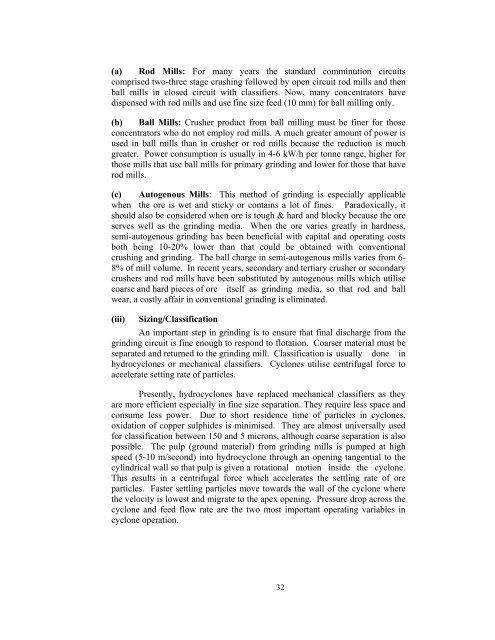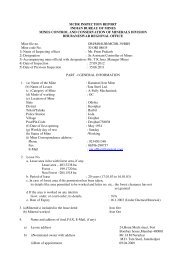Market Survey on Copper - Indian Bureau of Mines
Market Survey on Copper - Indian Bureau of Mines
Market Survey on Copper - Indian Bureau of Mines
Create successful ePaper yourself
Turn your PDF publications into a flip-book with our unique Google optimized e-Paper software.
(a) Rod Mills: For many years the standard comminuti<strong>on</strong> circuits<br />
comprised two-three stage crushing followed by open circuit rod mills and then<br />
ball mills in closed circuit with classifiers. Now, many c<strong>on</strong>centrators have<br />
dispensed with rod mills and use fine size feed (10 mm) for ball milling <strong>on</strong>ly.<br />
(b) Ball Mills: Crusher product from ball milling must be finer for those<br />
c<strong>on</strong>centrators who do not employ rod mills. A much greater amount <strong>of</strong> power is<br />
used in ball mills than in crusher or rod mills because the reducti<strong>on</strong> is much<br />
greater. Power c<strong>on</strong>sumpti<strong>on</strong> is usually in 4-6 kW/h per t<strong>on</strong>ne range, higher for<br />
those mills that use ball mills for primary grinding and lower for those that have<br />
rod mills.<br />
(c) Autogenous Mills: This method <strong>of</strong> grinding is especially applicable<br />
when the ore is wet and sticky or c<strong>on</strong>tains a lot <strong>of</strong> fines. Paradoxically, it<br />
should also be c<strong>on</strong>sidered when ore is tough & hard and blocky because the ore<br />
serves well as the grinding media. When the ore varies greatly in hardness,<br />
semi-autogenous grinding has been beneficial with capital and operating costs<br />
both being 10-20% lower than that could be obtained with c<strong>on</strong>venti<strong>on</strong>al<br />
crushing and grinding. The ball charge in semi-autogenous mills varies from 6-<br />
8% <strong>of</strong> mill volume. In recent years, sec<strong>on</strong>dary and tertiary crusher or sec<strong>on</strong>dary<br />
crushers and rod mills have been substituted by autogenous mills which utilise<br />
coarse and hard pieces <strong>of</strong> ore itself as grinding media, so that rod and ball<br />
wear, a costly affair in c<strong>on</strong>venti<strong>on</strong>al grinding is eliminated.<br />
(iii) Sizing/Classificati<strong>on</strong><br />
An important step in grinding is to ensure that final discharge from the<br />
grinding circuit is fine enough to resp<strong>on</strong>d to flotati<strong>on</strong>. Coarser material must be<br />
separated and returned to the grinding mill. Classificati<strong>on</strong> is usually d<strong>on</strong>e in<br />
hydrocycl<strong>on</strong>es or mechanical classifiers. Cycl<strong>on</strong>es utilise centrifugal force to<br />
accelerate setting rate <strong>of</strong> particles.<br />
Presently, hydrocycl<strong>on</strong>es have replaced mechanical classifiers as they<br />
are more efficient especially in fine size separati<strong>on</strong>. They require less space and<br />
c<strong>on</strong>sume less power. Due to short residence time <strong>of</strong> particles in cycl<strong>on</strong>es,<br />
oxidati<strong>on</strong> <strong>of</strong> copper sulphides is minimised. They are almost universally used<br />
for classificati<strong>on</strong> between 150 and 5 micr<strong>on</strong>s, although coarse separati<strong>on</strong> is also<br />
possible. The pulp (ground material) from grinding mills is pumped at high<br />
speed (5-10 m/sec<strong>on</strong>d) into hydrocycl<strong>on</strong>e through an opening tangential to the<br />
cylindrical wall so that pulp is given a rotati<strong>on</strong>al moti<strong>on</strong> inside the cycl<strong>on</strong>e.<br />
This results in a centrifugal force which accelerates the settling rate <strong>of</strong> ore<br />
particles. Faster settling particles move towards the wall <strong>of</strong> the cycl<strong>on</strong>e where<br />
the velocity is lowest and migrate to the apex opening. Pressure drop across the<br />
cycl<strong>on</strong>e and feed flow rate are the two most important operating variables in<br />
cycl<strong>on</strong>e operati<strong>on</strong>.<br />
32
















